Maybe you’ve seen Ellen Adamson playing her nyckelharpa at one of the local farmers markets. The instrument, which looks like a cross between a fiddle and an autoharp, is the national instrument of Sweden, but Adamson doesn’t know anyone else who plays it on Cape Cod. She also doesn’t know anyone else who does pyrography, her other eccentric passion.
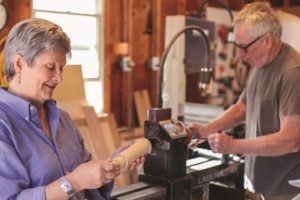
“I like to do things no one else is doing,” she says. She is in her basement studio in Brewster, surrounded by wooden objects awaiting her torch.
Pyrography — writing with fire — is an ancient art form in which hot objects, usually small torches and wood burners, are used to burn designs onto wooden objects. “Almost every culture has some version of it,” says Adamson. Wood burning was big at the turn of the last century, she says, a fact evidenced in her studio by a pair of antique boxes containing craft kits that could be sent through the mail.
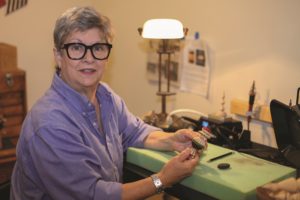
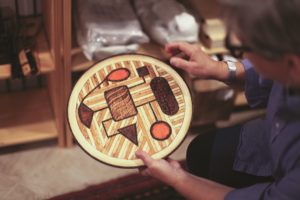
Adamson was first introduced to pyrography as a Girl Scout and then picked it up again in the early ’80s. “My mom was doing craft shows and asked me to burn designs into wooden spoons,” she says. “I got really into it and kept it up.” When Adamson retired from her career in retail management, she devoted more time to the craft and currently sells her work at Galley West Art Gallery in Orleans.
Adamson has been working her way through a large basket of wooden Christmas ornaments. “I set a challenge to not repeat myself,” she says, determined to cover each piece with a different design. She starts without a drawing or much planning, making up the patterns as she works. The results are reminiscent of designs found in folk art. She says she finds inspiration in wide-ranging sources, from ancient pottery to Mexican and Swedish patterns to tattoos.
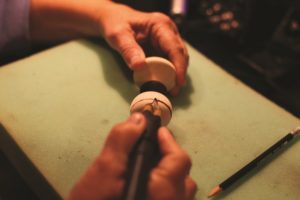
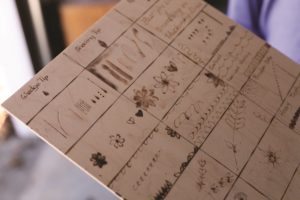
The wood burners Adamson uses can be found in any craft store. She works with a variety of tips to make different types of marks. “The spoon shader makes a really dark line,” she says. With a shading tip she’s able to achieve a petal-like shape, one she meticulously layered on one piece of wood to give the impression of fish scales. “The torch works like an airbrush,” she says. On a recently completed commission of a dragon, intended for the top of a toy chest, Adamson used a torch to darken large spaces of the dragon’s body. Other areas she painted with watercolor, which she often integrates into her work.
“The grain of the wood leads you in its own direction,” she says. “I try to incorporate that in the design.” She finds herself particularly inspired by the curvaceous grain of olive wood. She points to a cutting board in her studio that she decorated with a floral pattern.
On a circular box, Adamson created a pattern that spirals outward. After making a mistake, Adamson says, “I had to figure out a way to salvage it.” She can’t locate the error any longer, a testament to her knack for turning flaws into opportunities.
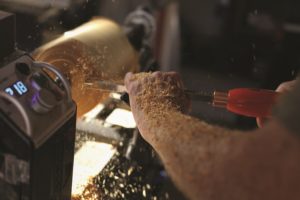
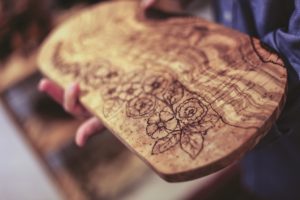
Though many of the wooden objects she has decorated were purchased, often on eBay, recently Adamson has started creating her own wooden objects with the help of her husband, Rob Richardson. Upstairs in their garage the couple has set up a small wood shop with a lathe that they use for turning wood.
Richardson has several blocks of wood drying on a shelf in the studio. He takes one and turns it on the lathe while cutting it with a blade, sending wood chips flying. Turning the block into a small box — something he and Adamson learned at the Cultural Center of Cape Cod in Yarmouth — will be a time-consuming process.
“I never did much woodworking before, other than maybe nailing a few boards together,” says Richardson, who is a retired Presbyterian minister.
It’s a good thing he’s enjoying the craft. With the holidays approaching, the two are in production mode. “Now he’s chained to the lathe,” says Adamson.
